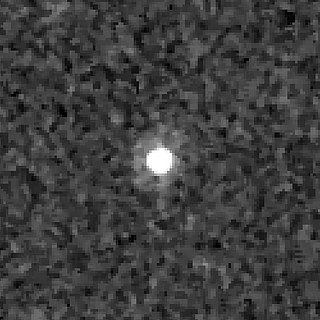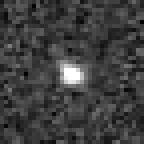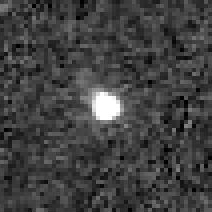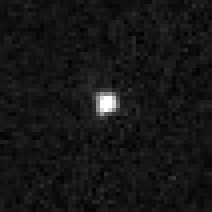Related Research Articles

(19308) 1996 TO66 (provisional designation 1996 TO66) is a trans-Neptunian object that was discovered in 1996 by Chadwick Trujillo, David Jewitt and Jane Luu. Until 20000 Varuna was discovered, it was the second-largest known object in the Kuiper belt, after Pluto.

(55565) 2002 AW197 (provisional designation 2002 AW197) is a classical, non-resonant trans-Neptunian object from the Kuiper belt in the outermost region of the Solar System, also known as a cubewano. With a likely diameter of at least 700 kilometers (430 miles), it is approximately tied with 2002 MS4 and 2013 FY27 (to within measurement uncertainties) as the largest unnamed object in the Solar System. It was discovered at Palomar Observatory in 2002.

7066 Nessus is a very red centaur on an eccentric orbit, located beyond Saturn in the outer Solar System. It was discovered on 26 April 1993, by astronomers of the Spacewatch program at the Kitt Peak National Observatory in Tucson, Arizona. The dark and reddish minor planet is likely elongated and measures approximately 60 kilometers in diameter. It was named after Nessus from Greek mythology.

(55636) 2002 TX300 is a bright Kuiper belt object in the outer Solar System estimated to be about 286 kilometres (178 mi) in diameter. It is a large member of the Haumea family that was discovered on 15 October 2002 by the Near-Earth Asteroid Tracking (NEAT) program.

(208996) 2003 AZ84 (provisional designation 2003 AZ84) is a trans-Neptunian object with a possible moon located in the outer regions of the Solar System. It is approximately 940 kilometers across its longest axis, as it has an elongated shape. It belongs to the plutinos – a group of minor planets named after its largest member Pluto – as it orbits in a 2:3 resonance with Neptune in the Kuiper belt. It is the third-largest known plutino, after Pluto and Orcus. It was discovered on 13 January 2003, by American astronomers Chad Trujillo and Michael Brown during the NEAT survey using the Samuel Oschin telescope at Palomar Observatory.
(24835) 1995 SM55 (provisional designation 1995 SM55) is a trans-Neptunian object and member of the Haumea family that resides in the Kuiper belt, located in the outermost region of the Solar System. It was discovered on 19 September 1995, by American astronomer Nichole Danzl of the Spacewatch program at Kitt Peak National Observatory near Tucson, Arizona, in the United States. It measures approximately 200 kilometers in diameter and was the second-brightest known object in the Kuiper belt, after Pluto, until 1996 TO66 was discovered.
(79983) 1999 DF9 (provisional designation 1999 DF9) is a trans-Neptunian object of the Kuiper belt, classified as a non-resonant cubewano, that measures approximately 270 kilometers in diameter.

(120178) 2003 OP32, also written as (120178) 2003 OP32, is a trans-Neptunian object (TNO) that resides in the Kuiper belt. It was discovered on July 26, 2003 by Michael E. Brown, Chad Trujillo and David L. Rabinowitz at Palomar Mountain in California.

(145453) 2005 RR43 (provisional designation 2005 RR43) is a trans-Neptunian object (TNO) estimated to be about 250 km in diameter. It was discovered on 9 September 2005 by Andrew Becker, Andrew Puckett and Jeremy Kubica at Apache Point Observatory in Sunspot, New Mexico.
(35671) 1998 SN165 (provisional designation 1998 SN165) is a trans-Neptunian object from the Kuiper belt located in the outermost region of the Solar System. It was discovered on 23 September 1998, by American astronomer Arianna Gleason at the Kitt Peak National Observatory near Tucson, Arizona. The cold classical Kuiper belt object is a dwarf planet candidate, as it measures approximately 400 kilometers (250 miles) in diameter. It has a grey-blue color (BB) and a rotation period of 8.8 hours. As of 2021, it has not been named.

(40314) 1999 KR16 is a trans-Neptunian object on an eccentric orbit in the outermost region of the Solar System, approximately 254 kilometers (158 miles) in diameter. It was discovered on 16 May 1999, by French astronomer Audrey Delsanti and Oliver Hainaut at ESO's La Silla Observatory in northern Chile. The very reddish object is a dwarf planet candidate and has a rotation period of 11.7 hours.

(86047) 1999 OY3 (provisional designation 1999 OY3) is a trans-Neptunian object that resides in the Kuiper belt beyond Pluto. It was discovered on July 18, 1999, at the Mauna Kea Observatory, Hawaii, USA.
83982 Crantor (provisional designation 2002 GO9) is a centaur in a 1:1 resonance with Uranus, approximately 60 kilometers (37 miles) in diameter. It was discovered on 12 April 2002, by astronomers of the Near-Earth Asteroid Tracking at the Palomar Observatory in California, United States. This minor planet was named for Crantor from Greek mythology.

31824 Elatus (; provisional designation 1999 UG5) is a very red centaur from the outer Solar System, approximately 48 kilometers (30 miles) in diameter. It was discovered on 29 October 1999, by astronomers of the Catalina Sky Survey at Mount Lemmon Observatory in Arizona, United States. The minor planet was named after Elatus, a centaur from Greek mythology.

32532 Thereus (; provisional designation 2001 PT13) is a centaur from the outer Solar System, approximately 80 kilometers (50 miles) in diameter. It was discovered on 9 August 2001, by astronomers of the Near-Earth Asteroid Tracking program at the Palomar Observatory in California, United States. This minor planet was named for the phrase thēreios bia 'beastly strength', used to describe centaurs in Greek mythology.

(308193) 2005 CB79 is a trans-Neptunian object that is a member of the Haumea family.
(55638) 2002 VE95 (provisional designation 2002 VE95) is a trans-Neptunian object from the outermost region of the Solar System. It was discovered on 14 November 2002, by astronomers with the Near-Earth Asteroid Tracking program at the Palomar Observatory in California, United States. This resonant trans-Neptunian object is a member of the plutino population, locked in a 2:3 resonance with Neptune. The object is likely of primordial origin with a heterogeneous surface and a notably reddish color (RR) attributed to the presence of methanol and tholins. It has a poorly defined rotation period of 6.8 hours and measures approximately 250 kilometers (160 miles) in diameter, too small to be a dwarf planet candidate. As of 2021, it has not yet been named.
(144897) 2004 UX10 (provisional designation 2004 UX10) is a Kuiper-belt object. It has a diameter of about 360 kilometres (220 mi) and was discovered by Andrew Becker, Andrew Puckett and Jeremy Kubica on 20 October 2004 at Apache Point Observatory in Sunspot, New Mexico. The object is classified as a cubewano. It is near a 2:3 resonance with Neptune.

(82158) 2001 FP185 (provisional designation 2001 FP185) is a highly eccentric trans-Neptunian object from the scattered disc in the outermost part of the Solar System, approximately 330 kilometers in diameter. It was discovered on 26 March 2001, by American astronomer Marc Buie at Kitt Peak National Observatory in Arizona, United States.

(416400) 2003 UZ117 (provisional designation 2003 UZ117) is a trans-Neptunian object and suspected member of the Haumea family, located in the Kuiper belt in the outermost region of the Solar System. It was discovered on 24 October 2003, by astronomers of the Spacewatch survey project at Kitt Peak Observatory, Arizona. The object may also be a non-resonant cubewano.
References
- 1 2 3 4 5 "JPL Small-Body Database Browser: 469306 (1999 CD158)" (2015-04-15 last obs.). Jet Propulsion Laboratory . Retrieved 2 June 2017.
- 1 2 3 4 5 "List of known trans-Neptunian objects". Johnstonsarchive.net. 18 August 2020. Retrieved 19 July 2021.
- 1 2 3 4 5 "469306 (1999 CD158)". Minor Planet Center. Retrieved 16 March 2017.
- ↑ Marc W. Buie (4 February 2012). "Orbit Fit and Astrometric record for 99CD158". SwRI (Space Science Department). Archived from the original on 16 June 2016. Retrieved 4 February 2012.
- ↑ JPL Horizons Observer Location: @sun (Perihelion occurs when deldot changes from negative to positive. Uncertainty in time of perihelion is 3-sigma.)
- 1 2 3 Thirouin, Audrey; Sheppard, Scott S.; Noll, Keith S.; Moskovitz, Nicholas A.; Ortiz, Jose Luis; Doressoundiram, Alain (June 2016). "Rotational Properties of the Haumea Family Members and Candidates: Short-term Variability". The Astronomical Journal. 151 (6): 20. arXiv: 1603.04406 . Bibcode:2016AJ....151..148T. doi: 10.3847/0004-6256/151/6/148 .
- 1 2 3 4 Belskaya, Irina N.; Barucci, Maria A.; Fulchignoni, Marcello; Dovgopol, Anatolij N. (April 2015). "Updated taxonomy of trans-neptunian objects and centaurs: Influence of albedo". Icarus. 250: 482–491. Bibcode:2015Icar..250..482B. doi:10.1016/j.icarus.2014.12.004 . Retrieved 16 March 2017.
- 1 2 3 "LCDB Data for (469306)". Asteroid Lightcurve Database (LCDB). Retrieved 16 March 2017.
- 1 2 3 4 Snodgrass, C.; Carry, B.; Dumas, C.; Hainaut, O. (February 2010). "Characterisation of candidate members of (136108) Haumea's family". Astronomy and Astrophysics. 511: 9. arXiv: 0912.3171 . Bibcode:2010A&A...511A..72S. doi:10.1051/0004-6361/200913031 . Retrieved 16 March 2017.
- 1 2 Carry, B.; Snodgrass, C.; Lacerda, P.; Hainaut, O.; Dumas, C. (August 2012). "Characterisation of candidate members of (136108) Haumea's family. II. Follow-up observations". Astronomy and Astrophysics. 544: 7. arXiv: 1207.6491 . Bibcode:2012A&A...544A.137C. doi:10.1051/0004-6361/201219044. S2CID 62880843 . Retrieved 16 March 2017.
- 1 2 3 Hainaut, O. R.; Boehnhardt, H.; Protopapa, S. (October 2012). "Colours of minor bodies in the outer solar system. II. A statistical analysis revisited". Astronomy and Astrophysics. 546: 20. arXiv: 1209.1896 . Bibcode:2012A&A...546A.115H. doi:10.1051/0004-6361/201219566. S2CID 54776793 . Retrieved 16 March 2017.
- ↑ AstDys Summary for 1999 CD158, retrieved 2012-02-04
- ↑ Peixinho, N.; Delsanti, A.; Guilbert-Lepoutre, A.; Gafeira, R.; Lacerda, P. (October 2012). "The bimodal colors of Centaurs and small Kuiper belt objects". Astronomy and Astrophysics. 546: 12. arXiv: 1206.3153 . Bibcode:2012A&A...546A..86P. doi:10.1051/0004-6361/201219057. S2CID 263789035 . Retrieved 16 March 2017.
- ↑ AstDys Ephmerides for 1999 CD158, retrieved 2012-02-04
- 1 2 Michael E. Brown (3 February 2012). "How many dwarf planets are there in the outer solar system?". California Institute of Technology . Retrieved 16 March 2017.